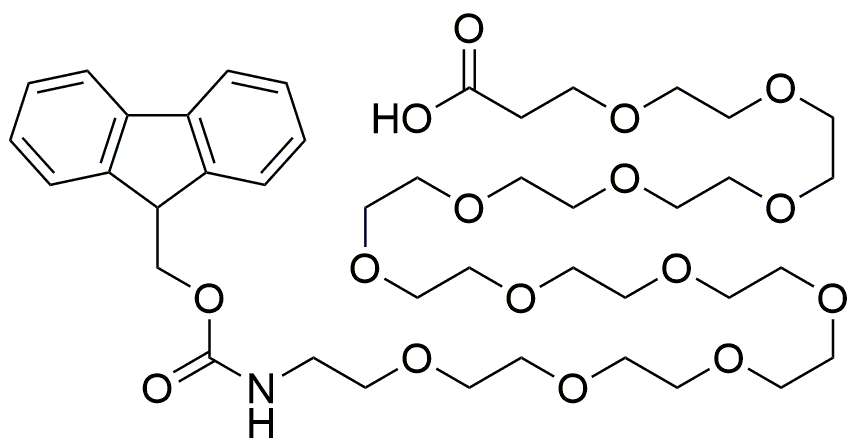(Fmoc-amino)-PEG12-C2-carboxylic acid is widely utilized in research focused on:
- Bioconjugation: This compound serves as a versatile linker in bioconjugation processes, allowing researchers to attach biomolecules, such as proteins or antibodies, to surfaces or other molecules, enhancing the development of targeted therapies.
- Drug Delivery Systems: Its amphiphilic nature makes it ideal for formulating drug delivery systems, improving the solubility and bioavailability of hydrophobic drugs, which is particularly beneficial in pharmaceutical applications.
- Polymer Chemistry: In polymer synthesis, it acts as a building block for creating functionalized polymers, which can be tailored for specific applications in materials science, such as coatings or adhesives.
- Diagnostics: The compound is used in the development of diagnostic tools, where its ability to form stable conjugates with biomolecules aids in the creation of sensitive assays for disease detection.
- Research in Nanotechnology: It plays a significant role in the fabrication of nanomaterials, enhancing their stability and functionality, which is crucial for advancements in nanomedicine and environmental applications.
General Information
Properties
Safety and Regulations
Applications
(Fmoc-amino)-PEG12-C2-carboxylic acid is widely utilized in research focused on:
- Bioconjugation: This compound serves as a versatile linker in bioconjugation processes, allowing researchers to attach biomolecules, such as proteins or antibodies, to surfaces or other molecules, enhancing the development of targeted therapies.
- Drug Delivery Systems: Its amphiphilic nature makes it ideal for formulating drug delivery systems, improving the solubility and bioavailability of hydrophobic drugs, which is particularly beneficial in pharmaceutical applications.
- Polymer Chemistry: In polymer synthesis, it acts as a building block for creating functionalized polymers, which can be tailored for specific applications in materials science, such as coatings or adhesives.
- Diagnostics: The compound is used in the development of diagnostic tools, where its ability to form stable conjugates with biomolecules aids in the creation of sensitive assays for disease detection.
- Research in Nanotechnology: It plays a significant role in the fabrication of nanomaterials, enhancing their stability and functionality, which is crucial for advancements in nanomedicine and environmental applications.
Documents
Safety Data Sheets (SDS)
The SDS provides comprehensive safety information on handling, storage, and disposal of the product.
Product Specification (PS)
The PS provides a comprehensive breakdown of the product’s properties, including chemical composition, physical state, purity, and storage requirements. It also details acceptable quality ranges and the product's intended applications.
Certificates of Analysis (COA)
Search for Certificates of Analysis (COA) by entering the products Lot Number. Lot and Batch Numbers can be found on a product’s label following the words ‘Lot’ or ‘Batch’.
Numéro de catalogue
Numéro de lot/série
Certificates Of Origin (COO)
This COO confirms the country where the product was manufactured, and also details the materials and components used in it and whether it is derived from natural, synthetic, or other specific sources. This certificate may be required for customs, trade, and regulatory compliance.
Numéro de catalogue
Numéro de lot/série
Safety Data Sheets (SDS)
The SDS provides comprehensive safety information on handling, storage, and disposal of the product.
DownloadProduct Specification (PS)
The PS provides a comprehensive breakdown of the product’s properties, including chemical composition, physical state, purity, and storage requirements. It also details acceptable quality ranges and the product's intended applications.
DownloadCertificates of Analysis (COA)
Search for Certificates of Analysis (COA) by entering the products Lot Number. Lot and Batch Numbers can be found on a product’s label following the words ‘Lot’ or ‘Batch’.
Numéro de catalogue
Numéro de lot/série
Certificates Of Origin (COO)
This COO confirms the country where the product was manufactured, and also details the materials and components used in it and whether it is derived from natural, synthetic, or other specific sources. This certificate may be required for customs, trade, and regulatory compliance.


